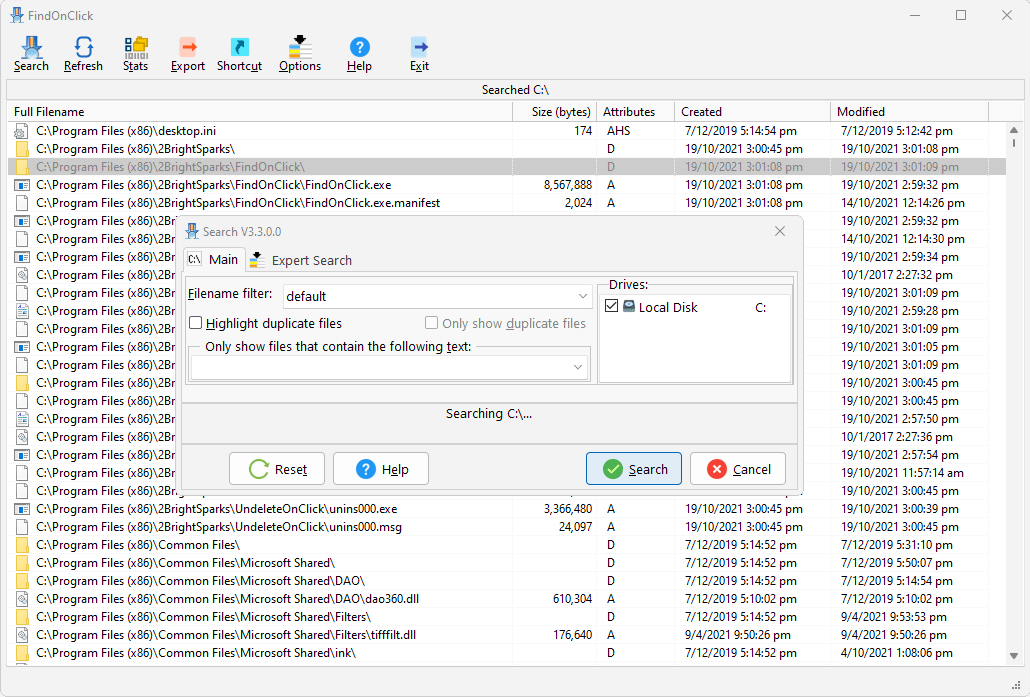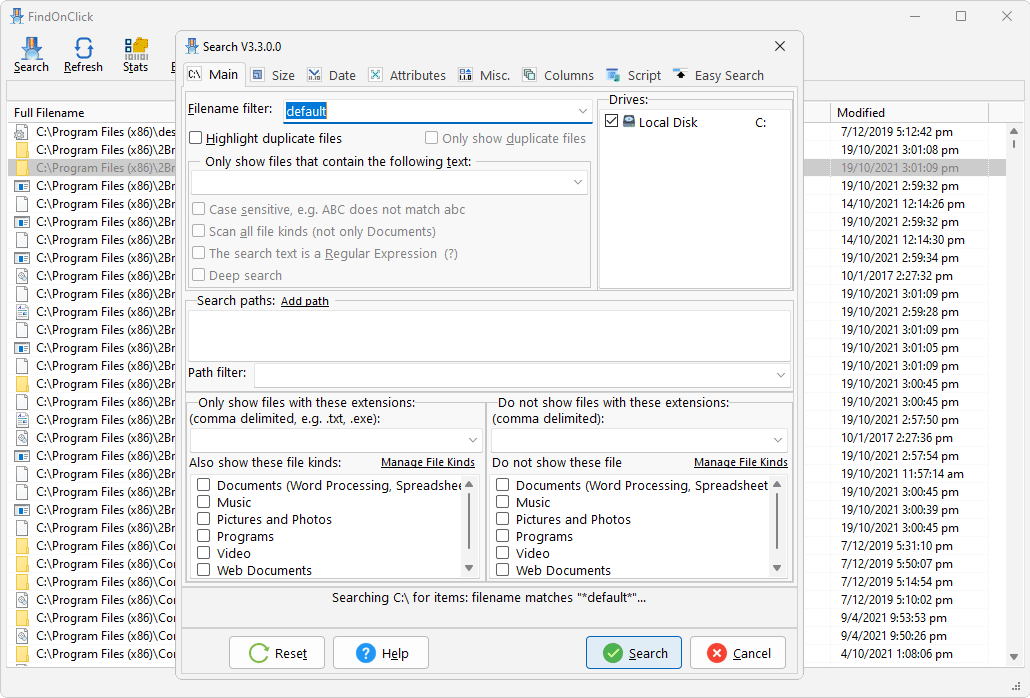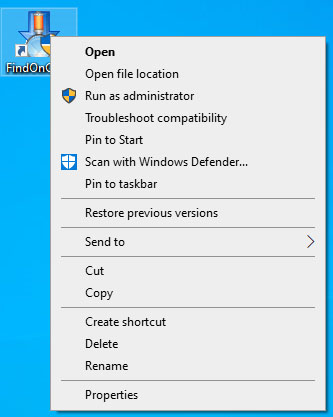
FindOnClick Frequently Asked Questions (FAQs)
Read through the FAQs listed below on this page which will help you understand FindOnClick better, and quickly solve any difficulties that you might encounter.
The following screenshots show the main functions available in FindOnClick:
Easy Mode Search
Easy Mode is the default mode in FindOnClick.

Expert Mode Search
Clicking the Expert Search tab above allows the user to search in Expert Mode:

The following screenshots show the search results windows. The first shows the right click menu in FindOnClick which allows you to quickly carry out search tasks and retrieve information on particular files:

The second search window shows the Windows File Explorer Context Menu when the right mouse button is pressed and held on an item:

Q: Do I need to be an Administrator to use this program? Why?
A: No, but FindOnClick can only search local drives at high speed when the program is run as an Administrator.
Q: Do I need to be an Administrator to install this program?
A: No, but you do need write access to the folder FindOnClick is installed to.
Q: Can I run this software from a USB key or other external storage device?
A: Yes. Copy the FindOnClick.exe, FindOnClick.exe.manifest and foc.dll and files to the external storage device.
|
You must be an Administrator on the computer you plug the external storage device into to be able to get the best performance from FindOnClick. |
Q: What type of files can I search for?
A: Any, but when searching network drives FindOnClick has to use the significantly slower standard Windows search method.
Q: What type of storage device can I search?
A: FindOnClick can seach any device that Windows can see in Explorer. For example, hard drives (internal and external), flash cards, USB keys, etc. If it is a network drive, or is not formatted with NTFS, FAT or exFAT, then FindOnClick has to use the slower standard Windows search method.
Q: Can FindOnClick search multiple drives at once?
A: Yes, you can search multiple drives, network drives, and paths at the same time.
Q: I do not want to list empty files (files with a size of zero bytes). How do I do that?
A: Click the Search button and change the value of 'Files must be larger than or equal to:' to 1.
Q: What are streams?
A: A file (on NTFS) can have more than one stream, where a stream is another representation of the file. Most files only have one stream, but NTFS encrypted files, for example, may have more than one stream where one of the streams contains information about the encryption.
Q: Why are some filenames in blue?
A: They are NTFS compressed files.
Q: Why are some filenames in green?
A: They are NTFS encrypted files.
Q: I perform the same search lots of times. Can I create a shortcut to do the search?
A: Run FindOnClick, specify your search parameters, go to the Misc. tab and click the “Click here to create a shortcut to perform this search” text. FindOnClick will create a shortcut on your desktop that when double-clicked will perform that search. Another method is to perform the search the click the Shortcut button on the main interface.
Q: I cannot see the file icons. Why not?
A: Make sure you are displaying the Filename column as the icon goes with the filename.
Q: What is a hash value, e.g. MD5 or SHA2?
A: A hash value uniquely identifies the contents of a file. If two files have the same contents they will have the same hash value. SHA2 is more reliable than MD5, but slower to calculate.
Q: Why is FindOnClick slow to return results?
A: When you enter search parameters in FindOnClick that will slow the search process, the program will warn you by showing an exclamation mark in the lower left corner of the Search window. Click your mouse on the exclamation graphic to see a list of reasons for the slower search:

Q: When I search a network path, or do not run FindOnClick as an Administrator, it s much slower. Why?
A: If you are searching a network drive, or the drive is not formatted with NTFS or FAT, then FindOnClick has to use the slower standard Windows search method. FindOnClick cannot use the fastest search method unless run by an Administrator. If you are using a Limited User type of account then you can run FindOnClick as an Administrator by right-clicking on it's icon, selecting "Run as administrator" and supplying the password for the administrative account as presented in the screenshot below:

Q: Why is the number of streams zero?
A: If you are using FindOnClick on a network drive, or the drive is not formatted with NTFS or FAT, or FindOnClick is not run as an Administrator, then it has to use the slower standard Windows search method. In this case the number of streams in a file is not returned.
Q: How do I disable Indexing in Windows?
A: Disabling the Indexing Service in Windows can improve your computer's performance significantly by saving disk space that was previously occupied by the index. As more documents are created on your disk the bigger the index becomes. The index size is between 6% to 30% of used space on your disk. FindOnClick users may wish to turn off the Indexing Service in Windows as FindOnClick returns far faster results. Warning! After disabling the indexing service your built-in Windows Search will stop functioning.
Q: How do I search for folders that match a name?
A: The path filter is used on the entire path. For example, if your path filter is test then it would match something like C:\abc\test\def\, C:\abc\test\def\ghi.txt, etc. In other words, it will also include all file, sub-folders (and their files, sub-folders, etc.) for a parent folder that matches.
If you want to just find folder names that match a name you can use the filename filter. To make sure it is only used with folders you must also go to the Attributes page and make sure Do not show files is checked. So if you leave the path filter empty (just for this example), and set the filename filter to test, then using the above example it would only return C:\abc\test\
Q: What does the error "file(s) could not be searched" mean?
A: If you are searching for files that contain certain text (i.e. searching the contents of files), or if you want the MP3 information, or if you want the file version information, then this error is given if one or more files cannot be opened. There are many reasons why a file cannot be opened, but the most likely reason is NTFS access rights. Even if you are an administrator, the NTFS access rights for a file may not allow you, as a user, to open that file.
Q: What other software does 2BrightSparks produce?
A: Visit our website www.2brightsparks.com and find out about our range of award-winning, powerful, and easy to use utility software.
All Content: 2BrightSparks Pte Ltd © 2003-2024